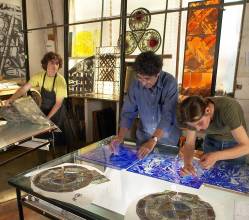Traditional craftsmanship is perhaps the most tangible manifestation of intangible cultural heritage. However, the 2003 Convention is mainly concerned with the skills and knowledge involved in craftsmanship rather than the craft products themselves. Rather than focusing on preserving craft objects, safeguarding attempts should instead concentrate on encouraging artisans to continue to produce craft and to pass their skills and knowledge onto others, particularly within their own communities.

© J. Ségur / ZED
There are numerous expressions of traditional craftsmanship: tools; clothing and jewellery; costumes and props for festivals and performing arts; storage containers, objects used for storage, transport and shelter; decorative art and ritual objects; musical instruments and household utensils, and toys, both for amusement and education. Many of these objects are only intended to be used for a short time, such as those created for festival rites, while others may become heirloom that are passed from generation to generation. The skills involved in creating craft objects are as varied as the items themselves and range from delicate, detailed work such as producing paper votives to robust, rugged tasks like creating a sturdy basket or thick blanket.
Like other forms of intangible cultural heritage, globalization poses significant challenges to the survival of traditional forms of craftsmanship. Mass production, whether on the level of large multinational corporations or local cottage industries, can often supply goods needed for daily life at a lower cost, both in terms of currency and time, than hand production. Many craftspeople struggle to adapt to this competition. Environmental and climatic pressures impact on traditional craftsmanship too, with deforestation and land clearing reducing the availability of key natural resources. Even in cases where traditional artisanship develops into a cottage industry, the increased scale of production may result in damage to the environment.

© Ministry of Culture and Tourism of the Republic of Indonesia
As social conditions or cultural tastes change, festivals and celebrations that once required elaborate craft production may become moreaustere, resulting in fewer opportunities for artisans to express themselves. Young people in communities may find the sometimes lengthy apprenticeship necessary to learn many traditional forms of craft too demanding and instead seek work in factories or service industry where the work is less exacting and the pay often better. Many craft traditions involve ‘trade secrets’ that should not be taught to outsiders but if family members or community members are not interested in learning it, the knowledge may disappear because sharing it with strangers violates tradition.
The goal of safeguarding, as with other forms of intangible cultural heritage, is to ensure that the knowledge and skills associated with traditional artisanry are passed on to future generations so that crafts can continue to be produced within their communities, providing livelihoods to theirmakers and reflecting creativity.
Many craft traditions have age-old systems of instruction and apprenticeship. One proven way of reinforcing and strengthening these systems is to offer financial incentives to students and teachers to make knowledge transfer more attractive to both.
Local, traditional markets for craft products can also be reinforced, while at the same time creating new ones. In response to urbanization and industrialization, many people around the world enjoy handmade objects that are imbued with the accumulated knowledge and cultural values of the craftspeople and which offer a softer alternative to the numerous ‘high tech’ items that dominate global consumer culture.

© Alexis Lecomte, Ministère de la Culture - France
In other cases, trees can be replanted to try and offset the damage done to traditional crafts reliant on wood for raw materials. In some situations, legal measures may need to be taken to guarantee the access rights of communities to gather resources, while also ensuring environmental protection.
Further legal measures, such as intellectual property protections and patent or copyright registrations, can help a community to benefit from its traditional motifs and crafts. Sometimes, legal measures intended for other purposes can encourage craft production; for example, a local ban on wasteful plastic bags can stimulate a market for handmade paper bags and containers woven from grass, allowing traditional craft skills and knowledge to thrive.